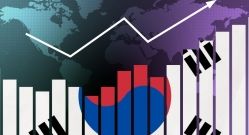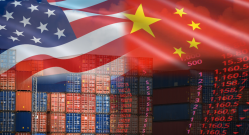
Macro-economic Scenario 2023-2024 – Normalisation plays hard to get
With a strong labour market and savings that remain abundant, albeit not untouched, household spending has absorbed the erosion of purchasing power and the rise in interest rates better than expected. Growth has also been more resilient than its forecasts, and core inflation has followed suit. The scenario for deceleration, but not collapse, hinges on the slow decline of inflation – a welcome respite for revenue and a green light for the end of monetary tightening measures. Here is hoping it happens soon and mitigates the inversion of yield curves.
The US economy has been resilient but is starting to crack, and these cracks get deeper as the repressive effects of monetary and financial tightening make themselves known. Housing investment has already experienced a sharp adjustment, and real investment in turn should fall substantially. After dipping into their savings and relying on credit, the consumers who underpinned such resilient growth may be less confident and more thrifty. While a stronger-than-expected labour market may allow for a soft landing, these fractures expose the economy to the risk of a recession in the second half of the year – a mild recession leading to average growth of roughly 1.2% in 2023 and just 0.7% in 2024. This slowdown, which is ultimately natural, is based on the assumption that headline inflation and especially core inflation will continue to fall, reaching approximately 3.2% and 3.6% respectively at end-2023 before they both descend to around 2.5% at end-2024. The risk weighing on this scenario is that inflation will be more persistent than expected, leading to a more aggressive monetary scenario than expected.
In the Eurozone, the path to “normalcy” is fairly straightforward. Absorbing shocks as out of the ordinary as the pandemic followed by an energy crisis has caused a fairly brutal drop in the pace of growth – one that does not foreshadow a recession, but rather a normalisation of behaviours exacerbated by that of economic policies which have switched gears from one-off support to a more restrictive direction. So the scenario is the result of opposing forces: the positive impact of tensions easing on the world’s value chains and energy prices settling is providing a positive countershock and offsetting – if only partially – the drag of economic policies on activity. Assuming average inflation falls from 8.4% in 2022 to 5.5% in 2023 and 2.9% in 2024, this scenario leads to modest growth of 0.6% in 2023 and 1.3% in 2024, which is still below its potential rate.
In the ‘emerging universe’, far from the glorious return it hoped for, China’s economy is struggling to regain its momentum. The deep household confidence crisis (fears over unemployment and increased rainy-day savings) as well as unresolved troubles on the real-estate market continue to justify stagnant domestic demand. This means inflation has weakened demand so much that the prospect of deflation hangs overhead. Chinese authorities cannot ignore the fact that this is not the recovery that was promised, but they still do not have the recovery tools they need to boost consumer spending. The annual growth target of “around 5%” cautiously announced by authorities should be achieved (thanks to favourable base effects), but doubts remain as to whether China can maintain this pace with no drivers to sustain activity in the medium term.
As for emerging countries in a very broad sense, as the global economy decelerates and a modest and more service-oriented Chinese recovery takes shape, there is a divide according to their level of openness. While growth in the major countries with strong domestic demand has proved more resilient than expected, the usual engines – the more advanced, more open countries that are more closely linked to the global technology cycle – are struggling a little more. However, all of them are likely to gradually benefit from slow monetary ‘normalisation’, which is conducive to a scenario of slowed growth with no crash.
But we have yet to finally see the key rates of major central banks clearly reach their peaks. While headline inflation has already fallen sharply in a largely mechanical fashion, persistent core inflation fuelled by higher-than-expected growth has led central banks to respond aggressively. If inflation keeps falling – especially core inflation – rate hikes should (finally) come to an end very soon.
After ten consecutive rate hikes totalling 500bp, the Federal Reserve just decided to maintain the status quo (upper limit of the Fed funds rate target range at 5.25%) while clearly indicating that further hikes could take place and presenting a dot plot which suggests another 50bp increase. Our neutral scenario for the economy is less optimistic than the Fed's and the median projection for 2023 is currently aggressive. The environment seems to vote in favour of stable key rates, but as the market suggests, a hike limited to 25bp is highly likely. As for the ECB, it should keep its monetary policy somewhat or even very restrictive in the coming quarters, as inflation is falling too slowly and there is still a long road ahead before achieving the target. As such, the ECB stands to raise its rates twice (once in July and once in September, bringing the deposit rate to 4%) while pursuing its monetary tightening policy.
Lastly, by clearly prioritising the fight against inflation over growth, monetary strategies helped keep inflation expectations from coming unglued and long-term rates from overreacting, but led to inverted yield curves and low-to-negative real yields. Unless inflation comes back with a vengeance, the risk of a rise in long-term ‘risk-free’ rates and a tangible increase in sovereign spreads within the Eurozone is limited. The risk that the curve will remain inverted in the long term is very real. Our scenario calls for 10Y US and German rates of approximately 3.75% and 2.60% at end-2023, respectively.
For further information, read our publication: World – Macro-economic Scenario 2023-2024: normalisation plays hard to get











